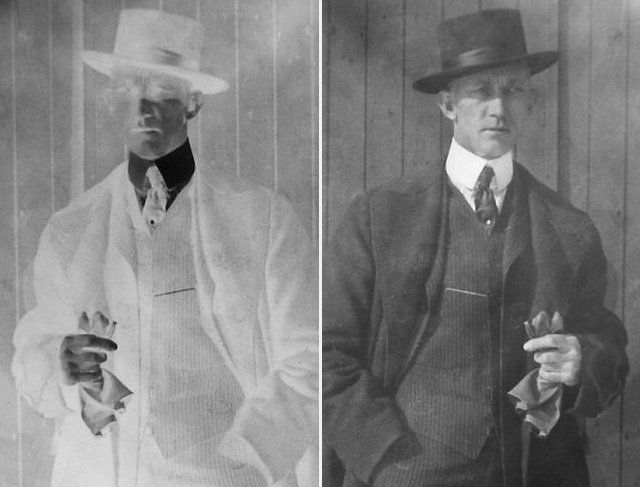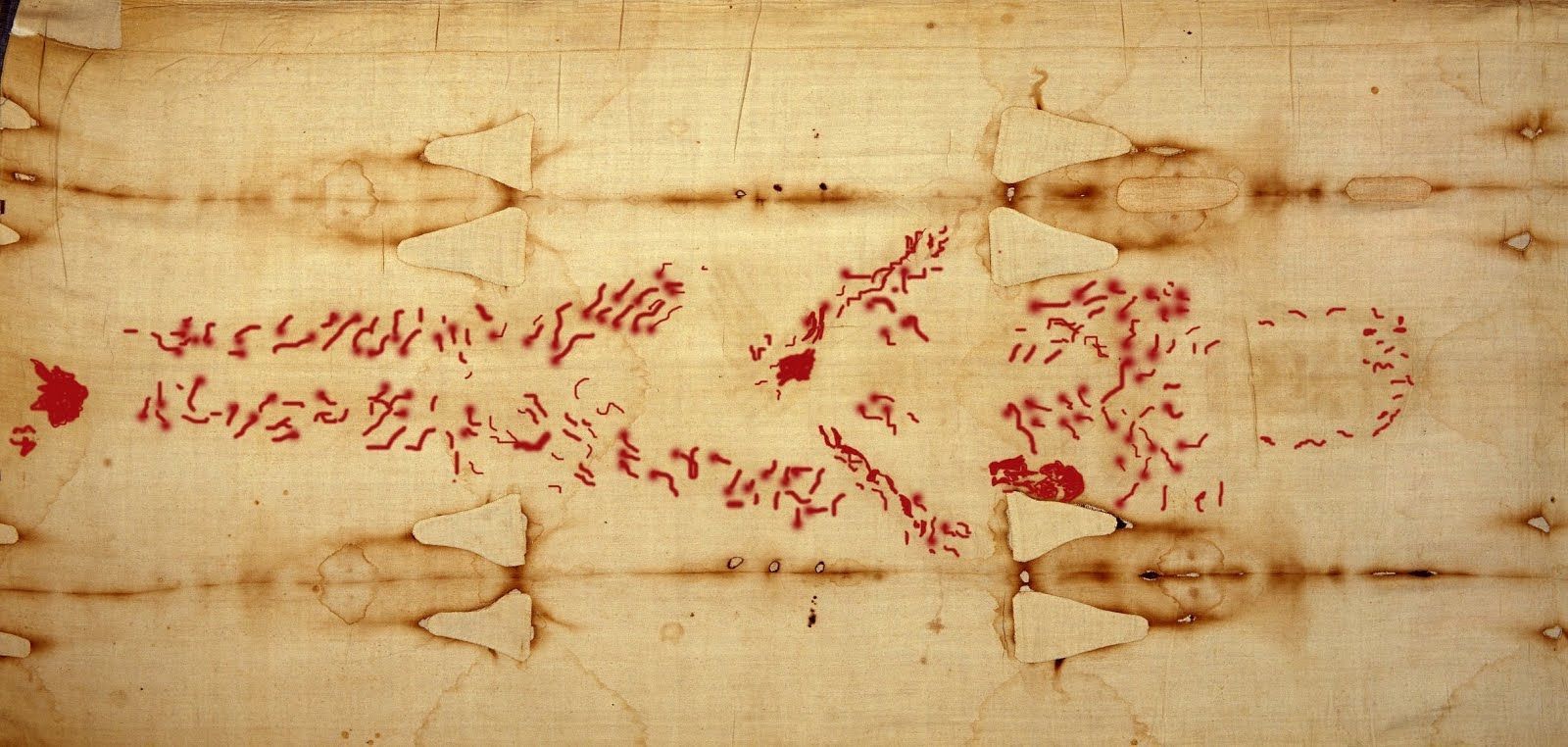Amazing progressions in photography - Oldest Photo in the world now examined at the nano-scale: Chemical analysis of a burial cloth proves a violent death
The world's oldest photograph is an enigma. Scientists cannot dispute that it exists, but they have not yet discovered HOW it was made.
Photographic Negatives
The concept of a negative image is pretty new. A negative is the first thing you get out of the camera when you take a picture. Because the camera is capturing light by essentially letting it burn into the capture medium (photographic plate, film, etc), something which is brighter to your eye will appear dark on the film, and something dark will appear light. Check out this image, which is negative on the left and positive (as your eye would see it) on the right. This still applies to digital cameras, because the camera's sensor is basically a solar array which measures intensity of light. Instead of a negative, however, the camera processes the data and develops a picture for us in one step.

This is the World's Oldest Photograph.

It is called the Shroud of Turin, and it is the most studied thing in the history of science. It even has its own named field of study, sindonology. It is at least as old as the 13th century, though almost everyone studying it now agrees that it is much older. It is a 14 foot long linen cloth which bears the image of the front and back of a dead man. The amazing thing about it, as far as this topic goes, is that IT IS A PHOTOGRAPHIC NEGATIVE OF A CRUCIFIED MAN. Even more amazing is the fact that there is no pigment in the picture. The image is not drawn or transferred using any technique known to science. It appears that the fibrils which make up the individual threads of linen have been rapidly aged to produce darkened areas.

Photographic Technology Paradox
As technology has progressed, we have become able to capture more and more detailed aspects of the subjects that we put in front of our capturing techniques and devices. In today's world, we have imaging processes that the ancient world could not begin to imagine. We have magnetic resonance imaging to see illnesses inside our bodies before any symptoms present. We can listen to the deepest reaches of space and make a visible image of it. We can see thru walls with x-rays, and we can map a room in 3-D using a wi-fi router. Pretty amazing stuff.
Nobody would seriously tell you that we can't be sure King Henry the 8th ever existed because we don't have a color photograph of him. There is plenty of other evidence out there for us to be certain that he was real.
Now what would happen if someone tried to tell you that they have a copy of King Henry's last chest X-Ray? You'd think they were mental. X-Ray photographs simply did not exist back then, and that is all you need to tell them. It's IMPOSSIBLE.
How on earth did we end up with a photographic negative that is at least 700 years older than the invention of negative photography? This is the impossible question that I am asking you not to ignore. Look into this further and you will be absolutely amazed at the extent of the science here. There are very serious folks researching this, and the more they answer, the more questions they have.
The shroud is ALSO a 100% accurate forensic record of an unnatural death.
The shroud bears the full body imprint, front and back, with bloodstains of a man who underwent a violent death.
The man on the shroud was 71 inches tall and weighed about 175 pounds. He bears the wounds of a classic roman crucifixion, with the added wounds from a roman flagrum,

and puncture wounds on his head, and a wound in his side exactly the same shape as a roman spear.
The Blood tells the Story

This is a photo of the shroud in which the bloodstains have been digitally highlighted.
The bloodstains are from blood produced both before and after the death of the man.
Chemically, blood from a living person is different from blood found inside a dead person. Peer-reviewed studies have confirmed the existence of both on the shroud.
The Shroud is so accurate, we can count how many times the man was whipped, what kind of whips were used, and even how tall the roman soldiers who inflicted the scourging were.
- Type 1 (about 35 % of scourge marks) consists of two or three round dots connected by small bars.
- Type 2 (about 65 % of scourge marks) is more numerous and consists of large striped bands of varying length, similar to scratches. They are randomly overlapped by Type 1 marks.
- Type 3 (less than 1 % of scourge marks) is rarer and fainter and it is a fan shaped scratch. It is present only on legs and calves, especially near the ankles. The first type corresponds to the imprint of the well-known Roman “Flagrum taxillatum”. The last two mark types most probably both originate from a different whip, a sort of bundle of flexible wood rods (“virgae”) or thin rigid leather cords (“Bucadae” or “Spanish cords”).
New study proves polytrauma violent death
From the study abstract:
We performed reproducible atomic resolution Transmission Electron Microscopy and Wide Angle X-ray Scanning Microscopy experiments studying for the first time the nanoscale properties of a pristine fiber taken from the Turin Shroud. We found evidence of biologic nanoparticles of creatinine bounded with small nanoparticles of iron oxide. The kind, size and distribution of the iron oxide nanoparticles cannot be dye for painting but are ferrihydrate cores of ferritin. The consistent bound of ferritin iron to creatinine occurs in human organism in case of a severe polytrauma. Our results point out that at the nanoscale a scenario of violence is recorded in the funeral fabric and suggest an explanation for some contradictory results so far published.
In english, They took 1 thread from the shroud and examined it using the finest resolution microscopes. They found nanoparticles of creatinine bonded with nanoparticles of iron oxide. This reaction occurs in humans who have been tortured to the point that their muscles and flesh start to dis-integrate.
From the study's conclusion
The bond between the iron cores of ferritin and creatinine on large scale occurs in a body after a strong polytrauma. This result cannot be impressed on the TS by using ancient dye pigments, as they have bigger sizes and tend to aggregate, and it is highly unlikely that the eventual ancient artist would have painted a fake by using the hematic serum of someone after a heavy polytrauma. Nevertheless, the presence of red pigments, detected in some studies seems to indicate a human intervention on the TS. This, in turn, has generated some difficulties for the modern investigations and stimulated the scientific debate about the actual origin of the TS. The analyses discussed in literature so far, have been realized without the necessary spatial resolution to distinguish what is coming from the nanoscale and cannot filter eventual artifacts. This has been the target of our work and the obtained results are not compatible with a painting but evidenced the presence of nanoparticles of pathologic blood serum related to the presence of creatinine bound with ferrihydrate, which are typical of an organism that suffered a strong polytrauma, like torture. Indeed, unexpectedly, at the nanoscale it is encoded a scenario of great suffering recorded on the nanoparticles attached to the linen fibers. Furthermore, here the experiments point how the nanoscale enable to study unspoiled properties of the Turin Shroud suggesting an effective experimental strategy for further studies.
Translation: Skeptics have argued that the presence of the color red on the Turin Shroud (TS) proves that it is a forgery, since blood does not dry red but rather to brown. What this study has proven is that the red bloodstains are the result of blood that has undergone chemical separation, due to intense torture. No medieval forger would have known anything about the nano-properties of blood in order to make this connection. If this was a fake, the bloodstains would be brown.
This is real, and it should make us think about the trauma suffered by the man in the shroud.
There is plenty more to this amazing artifact. As I noted above, it is the most-studied object in all of human history, and there is much more to learn about it. The next question I will attempt to answer is this: How was the image produced?


wow
Yes, Wow.
Congratulations @thomasaquinasftw! You have completed some achievement on Steemit and have been rewarded with new badge(s) :
Click on any badge to view your own Board of Honor on SteemitBoard.
For more information about SteemitBoard, click here
If you no longer want to receive notifications, reply to this comment with the word
STOPCongratulations! This post has been upvoted from the communal account, @minnowsupport, by taquinasftw from the Minnow Support Project. It's a witness project run by aggroed, ausbitbank, teamsteem, theprophet0, and someguy123. The goal is to help Steemit grow by supporting Minnows and creating a social network. Please find us in the Peace, Abundance, and Liberty Network (PALnet) Discord Channel. It's a completely public and open space to all members of the Steemit community who voluntarily choose to be there.
If you like what we're doing please upvote this comment so we can continue to build the community account that's supporting all members.
This post was upvoted by 20% from Operation Support sponsored with Whaleshares and BeyondBit !
